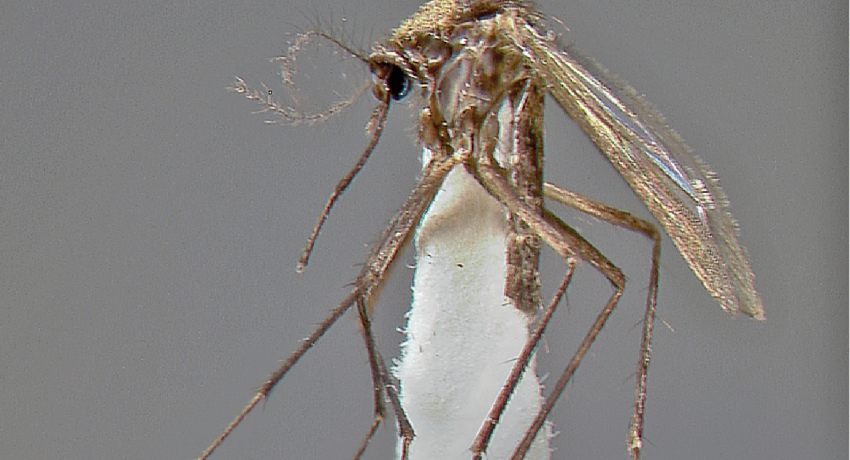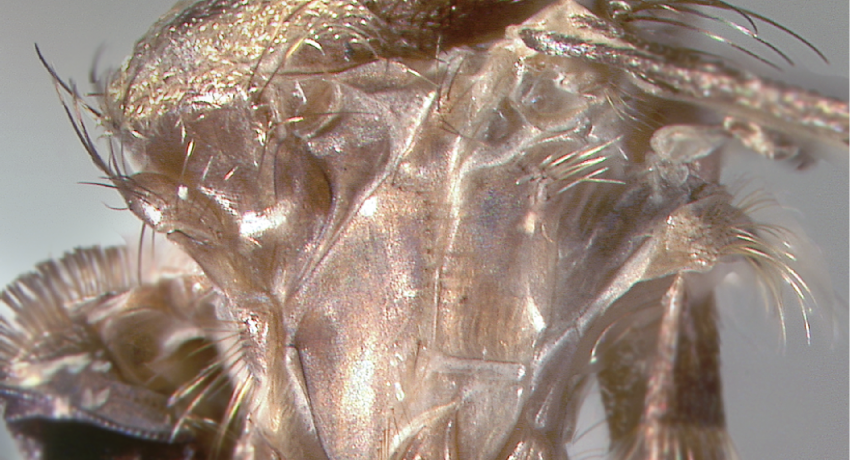NEOTROPICAL REGION
Etymology: thick footed (L): refers to thick flattened mid legs
The dark-legged species, Culex spissipes, is the monotypic species of the Spissipes Group, and nominotypical member of the Spissipes Section. The species has four synonyms: alvarezi Sutil Oramas, Pulido Florenzano & Amarista Meneses, fur Dyar & Knab, menytes Dyar, and haynei Komp & Curry. It is found in Trinidad & Tobago and throughout mainland Central and South America, from Mexico to southern Brazil and Paraguay.
Type locality: Trinidad [Trinidad & Tobago]
Type depository: Natural History Museum, London, England, United Kingdom (NHMUK)
DIAGNOSTIC CHARACTERS (Click photos to view; mouse over and click large photo to zoom in.)
ADULT (illustrated): Head: Narrow decumbent scales of vertex pale golden posteriorly, bronze anteriorly, and erect forked scales all dark. Thorax: Acrostichal setae present; mesokatepisternum without a patch of scales in upper corner. Legs: Ta-III1–5 all dark.
LARVA (not illustrated): No larval taxonomic study or drawings published (Not available).
TAXONOMIC KEYS
None
![]()
WRBU – Culex (Mel.) - Neotropical Region – Larva
Exemplar DNA sequences
Cx. spissipes COI: KX779868–70
BIONOMICS
Immatures
Female Cx. spissipes deposit their eggs in rafts directly on the water surface, or on wet leaves. Immature habitats are typically heavily shaded margins of freshwater ground pools, lakes and swamps with abundant emergent and floating vegetation, or submerged and floating fallen leaves.
Adults
Little adult bionomic data is available for Cx. spissipes. It bites throughout the night with its main peak at midnight, and two smaller peaks at dawn and dusk. Host-seeking female Cx. spissipes have been collected in mouse- and chicken-baited traps at night, in human-landing catches, and human-baited Shannon traps in forested areas, and on lake shores.
DISTRIBUTION NOTES
Belize, Bolivia, Brazil, Colombia, Ecuador, French Guiana, Guatemala, Guyana, Honduras, Mexico, Nicaragua, Panama, Paraguay, Peru, Suriname, Trinidad & Tobago, Venezuela.

WRBU VECTOR HAZARD REPORTS
None; View other WRBU Vector Hazard Reports
Available GIS Models:
Cx_spissipes_Dornak_1 South & Central America
IMPORTANT REFERENCES (full citations below)
Theobald 1903: 242 (F*, Melanoconion)
Bourroul 1904: 70 (distribution; Brazil)
Howard et al. 1915: 312 (M; taxonomy)
Dyar 1925f: 169 (distribution; Panama)
Dyar 1925g: 214 (distribution; Venezuela)
Bonne & Bonne-Wepster 1925: 268 (in part, Suriname; misidentification of M, see Takahashi 1968)
Martini 1935: 60 (distribution; Mexico, Belize)
Foote 1954: 94 (taxonomy)
Barreto 1955: 60 (distribution; Colombia)
Prosen et al. 1963 (1962): 110 (Lane cited for Bolivian record)
Takahashi 1968: 329 (M*, F*; taxonomy)
Galindo 1969: 87 (taxonomy; Spissipes Group)
Stone 1970: 164 (distribution; Honduras)
Heinemann & Belkin 1979: 108 (distribution; Ecuador)
Darsie & Hobbs 1982: 73 (distribution; Guatemala)
Sirivanakarn 1983: 278 (M*, F*)
Pecor et al. 1992: (M*; taxonomy, catalog citation, as alvarezi)
Sallum & Forattini 1996: 522 (M*, F*)
Pecor et al. 2000 (bionomics, distribution; Peru)
Navarro & Weaver 2004 (phylogenetics)
Berti et al. 2015 (distribution; Venezuela)
Torres-Gutierrez & Sallum 2015 (taxonomy, bionomics, distribution; catalog citation)
CURRENT SYNONYMS
syn. fur Dyar & Knab
1907a: 13 (F). Type locality: Colon, Canal Zone, Panama (USNM). References: Bonne-Wepster & Bonne 1921a: 20 (synonymy with spissipes); Lane 1951: 334 (from synonymy); Foote 1954: 94 (synonymy); Takahashi 1968: 329 (taxonomy).
syn. menytes Dyar
1918d: 125 (M). Type locality: Trinidad River, Panama (USNM). References: Rozeboom & Komp 1950a: 93 (M*; type locality information); Takahashi 1968: 331 (synonymy).
syn. haynei Komp & Curry
1932: 82 (M*). Type locality: Mojinga Swamp, lower Chagres River, Canal Zone, Panama (USNM). References: Komp 1935: 3 (synonymy); Stone & Knight 1957a: 59 (type information).
syn. alvarezi Sutil Oramas, Pulido Florenzano & Amarista Meneses
1987: 85 (M*). Type locality: Chiricoa, San Camillo, Apure, Venezuela (DERM). References: Sallum & Forattini 1996: 523 (synonymy).
CITED REFERENCES
Barreto-Reyes, P. (1955). Lista de mosquitos de Colombia, S.A. Revista Anales de la Sociedad de Biologia de Bogota, 7(2), 45–94.
Berti, J., Guzmán, H., Estrada, Y., & Ramírez, R. (2015). New records of mosquitoes (Diptera: Culicidae) from Bolívar State in South Eastern Venezuela, with 27 new species for the state and 5 of them new in the country. Frontiers in Public Health, 2, 10.
Bonne-Wepster, J., & Bonne, C. (1921a). Notes on South American mosquitoes in the British Museum (Diptera, Culicidae). Insecutor Inscitiae Menstruus, 9(1–3), 1–26.
Bonne, C., & Bonne-Wepster, J. (Eds.). (1925). Mosquitoes of Surinam. A study on Neotropical mosquitoes (Vol. 21). Amsterdam.
Bourroul, C. (1904). Mosquitos do Brasil. Faculdade de Medicina da Bahia, 78pp.
Darsie, R.F., Jr., & Hobbs, J.H. (1982). First report of Culex chrysonotum and Culex spissipes in Guatemala (Diptera, Culicidae). Mosquito Systematics, 14(1), 73–77.
Dyar, H.G. (1918d). New American mosquitoes (Diptera, Culicidae). Insecutor Inscitiae Menstruus, 6, 120–129.
Dyar, H.G. (1925f). The mosquitoes of Panama (Diptera, Culicidae). Insecutor Inscitiae Menstruus, 13, 101–195.
Dyar, H.G. (1925g). Some mosquitoes from Venezuela (Diptera, Culicidae). Insecutor Inscitiae Menstruus, 213–216.
Dyar, H.G., & Knab, F. (1907a). Descriptions of some American mosquitoes. Journal of the New York Entomological Society, 15, 9–13.
Foote, R. H. (1954). The larvae and pupae of the mosquitoes belonging to the Culex subgenera Melanoconion and Mochlostyrax. Technical Bulletin, United States Department of Agriculture.
Galindo, P. (1969). Notes on the systematics of Culex (Melanoconion) taeniopus Dyar and Knab and related species, gathered during arbovirus investigations in Panama. Mosquito Systematics, 1(4), 82–89.
Heinemann, S.J., & Belkin, J.N. (1979). Collection records of the project Mosquitoes of Middle America 13. South America: Brazil (BRA, BRAP, BRB), Ecuador (ECU), Peru (PER), Chile (CH). Mosquito Systematics, 11(2), 61–118.
Howard, L.O., Dyar, H.G. & Knab, F. 1915. The mosquitoes of North and Central America and the West Indies. Volume three. Systematic description (in two parts). Part I. Publication No. 159. Carnegie Institution of Washington, Washington, D.C.
Komp, W.H.W. (1935). Notes on the validity of the types of the species in the subgenera Mochlostyrax and Melanoconion in the U.S. National Museum. (Diptera, Culicidae). Proceedings of the Entomological Society of Washington, 37, 1–11.
Komp, W.H.W., & Curry, D.P. (1932). A new Culex from Panama (Dipt., Culicidae). Psyche, 39, 82–84.
Lane, J. (1951). Synonymy of Neotropical Culicidae (Diptera). Proceedings of the Entomological Society of Washington, 53, 333–336.
Martini, E. (1935). Los mosquitos de Mexico. Departamento de Salubridad Pública, Boletínes Tecnicos, Serie A: Entomología Médica y Parasitologia.
Navarro, J.-C., & Weaver, S.C. (2004). Molecular phylogeny of the Vomerifer and Pedroi groups in the Spissipes section of the subgenus Culex (Melanoconion). Journal of Medical Entomology, 41(4), 575–581.
Pecor, J.E., Jones, J., Turell, M.J., Fernancez, R., Carbajal, F., O'Guinn, M., . . . Klein, T.A. (2000). Annotated checklist of the mosquito species encountered during arboviral studies in Iquitos, Peru (Diptera: Culicidae). Journal of the American Mosquito Control Association, 16, 210–218.
Pecor, J.E., Mallampalli, V.L., Harbach, R.E., & Peyton, E.L. (1992). Catalog and illustrated review of the subgenus Melanoconion of Culex (Diptera: Culicidae). Contributions of the American Entomological Institute, 27, 1–228.
Prosen, A., Carcavallo., R.U., & Martínez, A. (1963). Culicidae de Bolivia (Diptera). Anales del Instituto de Medicina Regional, 6(1,2), 59–124.
Sallum, M.A.M., & Forattini, O.P. (1996). Revision of the Spissipes section of Culex (Melanoconion) (Diptera: Culicidae). Journal of the American Mosquito Control Association, 12(3), 517–600.
Sirivanakarn, S. (1983). A review of the systematics and a proposed scheme of internal classification of the New World subgenus Melanoconion of Culex (Diptera: Culicidae). Mosquito Systematics, 14 (1982)(4), 265–333.
Stone, A. (1970). A synoptic catalog of the mosquitoes of the world, suppl. IV (Diptera: Culicidae). Proceedings of the Entomological Society of Washington, 72(2), 137–171.
Stone, A., & Knight, K.L. (1957a). Type specimens of mosquitoes in the United States National Museum. IV: The genus Culex (Diptera, Culicidae). Journal of the Washington Academy of Sciences, 47(2), 42–59.
Sutil Oramas, E., Pulido, F.J., & Amarista, M.J.R. (1987). Dos espécies nuevas de Culex de Venezuela (Diptera: Culicidae). Boletín de la Dirección de Malariología y Saneamiento Ambiental, 27, 81–85.
Takahashi, M. (1968). Taxonomic and ecological notes on Culex (Melanoconion) spissipes (Theobald). Journal of Medical Entomology, 5, 329–331.
Theobald, F.V. (1903i). Description of a new North American Culex. Canadian Entomologist, 35, 211–213.
Torres-Gutierrez, C., & Sallum, M.A.M. (2015). Catalog of the subgenus Melanoconion of Culex (Diptera: Culicidae) for South America. Zootaxa, 4028(1), 1–50.
CITE THIS PAGE
Walter Reed Biosystematics Unit (Year). Culex spissipes species page. Walter Reed Biosystematics Unit Website, http://wrbu.si.edu/vectorspecies/mosquitoes/spissipes, accessed on [date (e.g. 03 February 2020) when you last viewed the site].










































































































































































